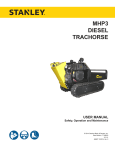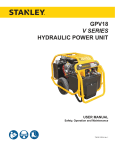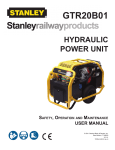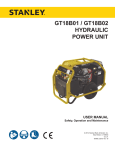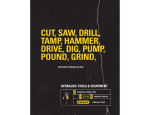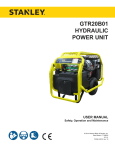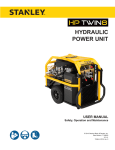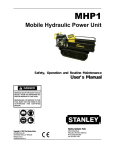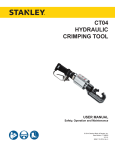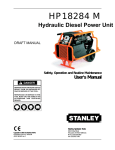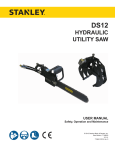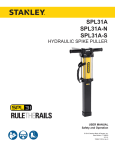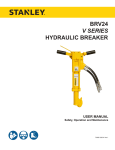Download mhp3 parts list - Stanley Hydraulic Tools
Transcript
MHP3 TracHorse Safety, Operation and Maintenance USER MANUAL © 2012 Stanley Black & Decker, Inc. New Britain, CT 06053 U.S.A. 68589 12/2013 Ver. 7 TABLE OF CONTENTS SAFETY SYMBOLS...................................................................................................................................................4 SAFETY PRECAUTIONS...........................................................................................................................................5 TOOL STICKERS & TAGS.........................................................................................................................................7 HOSE TYPES.............................................................................................................................................................8 HOSE RECOMMENDATIONS...................................................................................................................................9 HTMA REQUIREMENTS..........................................................................................................................................10 HOSE & FITTING CONNECTIONS......................................................................................................................... 11 OPERATION.............................................................................................................................................................12 TRACK TENSION ADJUSTMENT...........................................................................................................................19 TROUBLESHOOTING.............................................................................................................................................20 FUEL TANK..............................................................................................................................................................21 SPECIFICATIONS....................................................................................................................................................22 FILTERS...................................................................................................................................................................22 ACCESSORIES.......................................................................................................................................................22 MHP3 MAJOR PARTS ASSEMBLY ILLUSTRATION...............................................................................................23 MHP3 PARTS LIST—MAJOR ASSEMBLY..............................................................................................................24 HOSE & FITTING ILLUSTRATION..........................................................................................................................25 MHP3 PARTS LIST—HOSE & FITTING..................................................................................................................26 MHP3 ELECTRIC WIRING SCHEMATIC................................................................................................................27 MHP3 POWER UNIT FRAME ILLUSTRATION & PARTS LIST...............................................................................28 MHP3 HONDA ENGINE ILLUSTRATION................................................................................................................29 MHP3 HONDA ENGINE PARTS LIST......................................................................................................................30 IMPORTANT To fill out a Product Warranty Recording form, and for information on your warranty, visit Stanleyhydraulic.com and select the Warranty tab. (NOTE: The warranty recording form must be submitted to validate the warranty). SERVICING: This manual contains safety, operation, and routine maintenance instructions. Stanley Hydraulic Tools recommends that servicing of hydraulic tools, other than routine maintenance, must be performed by an authorized and certified dealer. Please read the following warning. WARNING SERIOUS INJURY OR DEATH COULD RESULT FROM THE IMPROPER REPAIR OR SERVICE OF THIS TOOL. REPAIRS AND / OR SERVICE TO THIS TOOL MUST ONLY BE DONE BY AN AUTHORIZED AND CERTIFIED DEALER. For the nearest authorized and certified dealer, call Stanley Hydraulic Tools at the number listed on the back of this manual and ask for a Customer Service Representative. MHP3 User Manual ◄ 3 SAFETY SYMBOLS Safety symbols and signal words, as shown below, are used to emphasize all operator, maintenance and repair actions which, if not strictly followed, could result in a life-threatening situation, bodily injury or damage to equipment. This is the safety alert symbol. It is used to alert you to potential personal injury hazards. Obey all safety messages that follow this symbol to avoid possible injury or death. DANGER This safety alert and signal word indicate an imminently hazardous situation which, if not avoided, will result in death or serious injury. WARNING This safety alert and signal word indicate a potentially hazardous situation which, if not avoided, could result in death or serious injury. CAUTION This safety alert and signal word indicate a potentially hazardous situation which, if not avoided, could result in death or serious injury. CAUTION This signal word indicates a potentially hazardous situation which, if not avoided, may result in property damage. NOTICE This signal word indicates a situation which, if not avoided, will result in damage to the equipment. IMPORTANT This signal word indicates a situation which, if not avoided, may result in damage to the equipment. Always observe safety symbols. They are included for your safety and for the protection of the tool. LOCAL SAFETY REGULATIONS Enter any local safety regulations here. Keep these instructions in an area accessible to the operator and maintenance personnel. 4 ► MHP3 User Manual SAFETY PRECAUTIONS Tool operators and maintenance personnel must always comply with the safety precautions given in this manual and on the stickers and tags attached to the machine. • Establish a training program for all operators to ensure safe operation. • DO NOT operate the machine unless thoroughly trained or under the supervision of an instructor. • Always wear safety equipment such as goggles, ear, head protection, respiratory and safety shoes at all times when operating the TracHorse and hydraulic tools. • If you have not read this manual or the engine manual, you are not ready to operate the MHP3. Read and understand this manual and any stickers and tags attached to the machine before operation. Failure to do so can result in equipment damage, personal injury, or death. DO NOT inspect or clean the machine while the engine is running. Accidental engagement of the machine can cause serious injury or death. • Wear a homologated respirator when cutting or breaking masonry, concrete, asbestos and other materials that produce dust. • The hydraulic circuit control switch must be in the “OFF”position when coupling or uncoupling hydraulic tools. Wipe all couplers clean before connecting. Use only lint-free cloths. Failure to do so may result in damage to the quick couplers and cause overheating of the hydraulic system. • Operate the machine in a work area WITHOUT BYSTANDERS. The operator must be familiar with all prohibited work areas such as excessive slopes and dangerous terrain conditions. • Before operating hydraulic tools, read and understand the operation manual furnished with the tool. • DO NOT operate a damaged, or improperly adjusted, machine. DO NOT operate with guards removed. • DO NOT operate the machine ACROSS excessive slopes or unstable terrain where “tip over” is a hazard. • • DO NOT operate the machine in confined areas where there may be a risk of crushing the operator between the machine and another object. DO NOT weld or cut with an acetylene torch any surface or component of the equipment. Consult with the Stanley factory before performing any welding or acetylene cutting of the equipment. • Prevent possible personal injury or equipment damage by having all repair, maintenance and service performed only by authorized and properly trained personnel. • DO NOT exceed the rated limits of the equipment or use the equipment for applications beyond its design capacity. • Always keep critical markings, such as labels and warning stickers legible. • Always replace parts with replacement parts recommended by Stanley Hydraulic Tools. • Keep all body parts away from working parts of the TracHorse. • Be aware of surrounding hazards. Noise created by the TracHorse and the tools it operates may mask early indications of approaching hazards. • Only use the TracHorse in well-ventilated areas. DO NOT operate in explosive atmospheres, in closed environments or near flammable substances. These safety precautions are given for your safety. Review them carefully before operating the machine and before performing general maintenance or routine service. Supervising personnel should develop additional precautions relating to the specific work area and local safety regulations. If so, place the added precautions in the space provided in this manual. • DO NOT OPERATE THE TRACHORSE IN ENCLOSED SPACES. Inhalation of engine exhaust can be fatal. • DO NOT WEAR LOOSE CLOTHING that can get entangled in the working parts of the machine or hydraulic tools. • DO NOT add fuel to the machine while it is running or still hot. • DO NOT operate the machine if a fuel odor is present. • DO NOT operate the machine within 3.3 ft./1 m of buildings, obstructions, or flammable objects. • Allow the engine to cool before storing the machine in an enclosure. • DO NOT RIDE ON, OR ALLOW ANYONE ELSE TO RIDE ON, THE MACHINE AT ANY TIME. MHP3 User Manual ◄ 5 SAFETY PRECAUTIONS • Always be well-rested and mentally alert when operating the TracHorse and tools. DO NOT operate if affected by medications, drugs or alcohol. • Keep clear of hot (engine) parts and exhaust. • DO NOT use flammable solvents around the engine. • DO NOT reverse tool rotation by changing fluid flow direction. • Always use hose and fittings rated for 2500 psi/172 bar with a 4 to 1 safety factor. Be sure all hose connections are tight. • Be sure all hoses are correct for current flow direction to and from the tool being used. • DO NOT inspect hoses and fittings for leaks by using bare hands. “Pin-hole” leaks can penetrate the skin. • DO NOT operate tools if oil temperature exceeds 140 °F/60 °C. Operation at high temperatures can cause higher than normal temperatures at the tools which can result in operator discomfort. • Disconnect battery before servicing electrical components. Electrocution or burns could result from improper contact. 6 ► MHP3 User Manual TOOL STICKERS & TAGS 59126 Dash Sticker Use in well ventilated areas only. Exhaust contains chemicals known to the state of California to cause cancer, birth defects, and other reproductive harm. Contact with high pressure fluid at leak or burst resulting from improper handling, operation, or maintenance will cause oil injection to body. Engine, exhaust, and other surfaces of tool may be hot. Avoid accidental contact with hot surfaces. Allow tool to cool before maintenance or storage. All operators must read, understand, and follow ALL saftey precautions and operating instructions found in owners manual before operating tool. 68336 Dual Tool Circuit Sticker 47352 Lift Point Sticker 59126 Dash Sticker (Closer View) 68334 Limit Engine Speed Sticker 68335 Throttle Sticker MHP3 User Manual ◄ 7 HOSE TYPES The rated working pressure of the hydraulic hose must be equal to or higher than the relief valve setting on the hydraulic system. There are three types of hydraulic hose that meet this requirement and are authorized for use with Stanley Hydraulic Tools. They are: Certified non-conductive — constructed of thermoplastic or synthetic rubber inner tube, synthetic fiber braid reinforcement, and weather resistant thermoplastic or synthetic rubber cover. Hose labeled certified nonconductive is the only hose authorized for use near electrical conductors. Wire-braided (conductive) — constructed of synthetic rubber inner tube, single or double wire braid reinforcement, and weather resistant synthetic rubber cover. This hose is conductive and must never be used near electrical conductors. Fabric-braided (not certified or labeled non-conductive) — constructed of thermoplastic or synthetic rubber inner tube, synthetic fiber braid reinforcement, and weather resistant thermoplastic or synthetic rubber cover. This hose is not certified non-conductive and must never be used near electrical conductors. HOSE SAFETY TAGS To help ensure your safety, the following DANGER tags are attached to all hose purchased from Stanley Hydraulic Tools. DO NOT REMOVE THESE TAGS. If the information on a tag is illegible because of wear or damage, replace the tag immediately. A new tag may be obtained from your Stanley Distributor. D A N G E R D A N G E R 1. FAILURE TO USE HYDRAULIC HOSE LABELED AND CERTIFIED AS NON-CONDUCTIVE WHEN USING HYDRAULIC TOOLS ON OR NEAR ELECTRIC LINES MAY RESULT IN DEATH OR SERIOUS INJURY. FOR PROPER AND SAFE OPERATION MAKE SURE THAT YOU HAVE BEEN PROPERLY TRAINED IN CORRECT PROCEDURES REQUIRED FOR WORK ON OR AROUND ELECTRIC LINES. 2. BEFORE USING HYDRAULIC HOSE LABELED AND CERTIFIED AS NON-CONDUCTIVE ON OR NEAR ELECTRIC LINES. WIPE THE ENTIRE LENGTH OF THE HOSE AND FITTING WITH A CLEAN DRY ABSORBENT CLOTH TO REMOVE DIRT AND MOISTURE AND TEST HOSE FOR MAXIMUM ALLOWABLE CURRENT LEAKAGE IN ACCORDANCE WITH SAFETY DEPARTMENT INSTRUCTIONS. 3. DO NOT EXCEED HOSE WORKING PRESSURE OR ABUSE HOSE. IMPROPER USE OR HANDLING OF HOSE COULD RESULT IN BURST OR OTHER HOSE FAILURE. KEEP HOSE AS FAR AWAY AS POSSIBLE FROM BODY AND DO NOT PERMIT DIRECT CONTACT DURING USE. CONTACT AT THE BURST CAN CAUSE BODILY INJECTION AND SEVERE PERSONAL INJURY. 4. HANDLE AND ROUTE HOSE CAREFULLY TO AVOID KINKING, ABRASION, CUTTING, OR CONTACT WITH HIGH TEMPERATURE SURFACES. DO NOT USE IF KINKED. DO NOT USE HOSE TO PULL OR LIFT TOOLS, POWER UNITS, ETC. 5. CHECK ENTIRE HOSE FOR CUTS CRACKS LEAKS ABRASIONS, BULGES, OR DAMAGE TO COUPLINGS IF ANY OF THESE CONDITIONS EXIST, REPLACE THE HOSE IMMEDIATELY. NEVER USE TAPE OR ANY DEVICE TO ATTEMPT TO MEND THE HOSE. 6. AFTER EACH USE STORE IN A CLEAN DRY AREA. SEE OTHER SIDE SIDE 1 SEE OTHER SIDE (Shown smaller than actual size) DO NOT REMOVE THIS TAG DO NOT REMOVE THIS TAG THE TAG SHOWN BELOW IS ATTACHED TO “CERTIFIED NON-CONDUCTIVE” HOSE SIDE 2 D A N G E R D A N G E R 1. DO NOT USE THIS HYDRAULIC HOSE ON OR NEAR ELECTRIC LINES. THIS HOSE IS NOT LABELED OR CERTIFIED AS NON-CONDUCTIVE. USING THIS HOSE ON OR NEAR ELECTRICAL LINES MAY RESULT IN DEATH OR SERIOUS INJURY. 5. CHECK ENTIRE HOSE FOR CUTS CRACKS LEAKS ABRASIONS, BULGES, OR DAMAGE TO COUPLINGS IF ANY OF THESE CONDITIONS EXIST, REPLACE THE HOSE IMMEDIATELY. NEVER USE TAPE OR ANY DEVICE TO ATTEMPT TO MEND THE HOSE. 2. FOR PROPER AND SAFE OPERATION MAKE SURE THAT YOU HAVE BEEN PROPERLY TRAINED IN CORRECT PROCEDURES REQUIRED FOR WORK ON OR AROUND ELECTRIC LINES. 6. AFTER EACH USE STORE IN A CLEAN DRY AREA. 3. DO NOT EXCEED HOSE WORKING PRESSURE OR ABUSE HOSE. IMPROPER USE OR HANDLING OF HOSE COULD RESULT IN BURST OR OTHER HOSE FAILURE. KEEP HOSE AS FAR AWAY AS POSSIBLE FROM BODY AND DO NOT PERMIT DIRECT CONTACT DURING USE. CONTACT AT THE BURST CAN CAUSE BODILY INJECTION AND SEVERE PERSONAL INJURY. 4. HANDLE AND ROUTE HOSE CAREFULLY TO AVOID KINKING, CUTTING, OR CONTACT WITH HIGH TEMPERATURE SURFACES. DO NOT USE IF KINKED. DO NOT USE HOSE TO PULL OR LIFT TOOLS, POWER UNITS, ETC. SEE OTHER SIDE SEE OTHER SIDE SIDE 1 SIDE 2 (Shown smaller than actual size) 8 ► MHP3 User Manual DO NOT REMOVE THIS TAG DO NOT REMOVE THIS TAG THE TAG SHOWN BELOW IS ATTACHED TO “CONDUCTIVE” HOSE. All hydraulic hose must meet or exceed specifications as set forth by SAE J517. All hydraulic hose must have at least a rated minimum working pressure equal to the maximum hydraulic system relief valve setting. This chart is intended to be used for hydraulic tool applications only based on Stanley Hydraulic Tools tool operating requirements and should not be used for any other applications. The chart to the right shows recommended minimum hose diameters for various hose lengths based on gallons per minute (gpm)/ liters per minute (lpm). These recommendations are intended to keep return line pressure (back pressure) to a minimum acceptable level to ensure maximum tool performance. Tool to Hydraulic Circuit Hose Recommendations 15-34 MM Inside Diameter INCH USE (Press/Return) PSI up to 10 up to 3 3/8 10 Both 2250 49-60 13-16 FLOW >>> RETURN <<< FLOW PRESSURE 26-100 up to 25 100-200 51-100 up to 50 100-300 51-100 up to 50 26-100 up to 25 8-30 up to 8 30-60 15-30 up to 15 30-90 15-30 up to 15 7.5-30 up to 7.5 Figure 1. Typical Hose Connections 49-60 38-49 10-13 13-16 19-40 5-10.5 38-49 19-40 5-10.5 10-13 19-40 5-10.5 38-49 15-23 10-13 15-23 4-6 19 25.4 16 19 19 25.4 5/8 3/4 3/4 1 19 3/4 1 16 3/4 16 19 3/4 5/8 16 5/8 5/8 16 13 13 10 5/8 1/2 1/2 3/8 Return Pressure Return Pressure Return Pressure Return Pressure Both Return Pressure Both Both Both Both 2500 2500 2500 2500 2500 2500 2500 2500 2500 2500 2500 2500 2500 2500 2500 175 175 175 175 175 175 175 175 175 175 175 175 175 175 175 155 BAR Min. Working Pressure Certified Non-Conductive Hose - Fiber Braid - for Utility Bucket Trucks METERS Hose Lengths FEET Conductive Hose - Wire Braid or Fiber Braid -DO NOT USE NEAR ELECTRICAL CONDUCTORS 4-6 4-9 LPM Oil Flow GPM HOSE RECOMMENDATIONS MHP3 User Manual ◄ 9 HTMA / EHTMA REQUIREMENTS HTMA / EHTMA REQUIREMENTS HTMA HYDRAULIC SYSTEM REQUIREMENTS TYPE I Nominal Operating Pressure (at the power supply outlet) 4-6 gpm (15-23 lpm) 1500 psi (103 bar) TOOL TYPE TYPE II TYPE RR 7-9 gpm (26-34 lpm) 1500 psi (103 bar) 9-10.5 gpm (34-40 lpm) 1500 psi (103 bar) System relief valve setting (at the power supply outlet) 2100-2250 psi (145-155 bar) 2100-2250 psi (145-155 bar) 2200-2300 psi (152-159 bar) 2100-2250 psi (145-155 bar) Maximum back pressure (at tool end of the return hose) 250 psi (17 bar) 250 psi (17 bar) 250 psi (17 bar) 250 psi (17 bar) Measured at a max. fluid viscosity of: (at min. operating temperature) 400 ssu* 400 ssu* 400 ssu* 400 ssu* (82 centistokes) (82 centistokes) (82 centistokes) (82 centistokes) Temperature: Sufficient heat rejection capacity to limit max. fluid temperature to: (at max. expected ambient temperature) 140° F (60° C) Flow Range 140° F (60° C) 140° F (60° C) TYPE III 11-13 gpm (42-49 lpm) 1500 psi (103 bar) 140° F (60° C) 3 hp 5 hp 6 hp 7 hp Min. cooling capacity at a temperature (2.24 kW) (3.73 kW) (5.22 kW) (4.47 kW) difference of between ambient and fluid 40° F 40° F 40° F 40° F temps (22° C) (22° C) (22° C) (22° C) NOTE: Do not operate the tool at oil temperatures above 140° F (60° C). Operation at higher temperatures can cause operator discomfort at the tool. Filter Min. full-flow filtration Sized for flow of at least: (For cold temp. startup and max. dirt-holding capacity) 25 microns 30 gpm (114 lpm) Hydraulic fluid Petroleum based (premium grade, anti-wear, non-conductive) Viscosity (at min. and max. operating temps) 100-400 ssu* 25 microns 30 gpm (114 lpm) 25 microns 30 gpm (114 lpm) 100-400 ssu* 100-400 ssu* (20-82 centistokes) 25 microns 30 gpm (114 lpm) 100-400 ssu* NOTE: When choosing hydraulic fluid, the expected oil temperature extremes that will be experienced in service determine the most suitable temperature viscosity characteristics. Hydraulic fluids with a viscosity index over 140 will meet the requirements over a wide range of operating temperatures. *SSU = Saybolt Seconds Universal EHTMA HYDRAULIC SYSTEM REQUIREMENTS CLASSIFICATION B C D Nominal Operating Pressure (at the power supply outlet) 3.5-4.3 gpm (13.5-16.5 lpm) 1870 psi (129 bar) 4.7-5.8 gpm (18-22 lpm) 1500 psi (103 bar) 7.1-8.7 gpm (27-33 lpm) 1500 psi (103 bar) 9.5-11.6 gpm (36-44 lpm) 1500 psi (103 bar) 11.8-14.5 gpm (45-55 lpm) 1500 psi (103 bar) System relief valve setting (at the power supply outlet) 2495 psi (172 bar) 2000 psi (138 bar) 2000 psi (138 bar) 2000 psi (138 bar) 2000 psi (138 bar) Flow Range NOTE: These are general hydraulic system requirements. See tool specification page for tool specific requirements 10 ► MHP3 User Manual HOSE & FITTING CONNECTIONS POWER UNIT PANEL HTMA 1/2 INCH MALE QUICK DISCONNECT COUPLER (STANLEY P/N 58857 COUPLER NOSE OR STANLEY P/N 58718 COUPLER SET – NOSE & BODY) HTMA 1/2 INCH FEMALE QUICK DISCONNECT COUPLER (STANLEY P/N 58856 COUPLER BODY or STANLEY P/N 58718 COUPLER SET – NOSE & BODY) 1/2 INCH ID HOSE, 25 FT TO 50 FT LONG. (FOR 25 FEET, STANLEY P/N 31972 HYDRAULIC HOSE OR STANLEY P/N 58633 TWINNED HYDRAULIC HOSES OR 58451 2-WIRE BRAID HYDRAULIC HOSE) (FOR 50 FEET, STANLEY P/N 31848 HYDRAULIC HOSE OR STANLEY P/N 58634 TWINNED HYDRAULIC HOSES OR 58448 2-WIRE BRAID HYDRAULIC HOSE) 1/2 INCH MALE PIPE HOSE END HTMA 1/2 INCH MALE QUICK DISCONNECT COUPLER (STANLEY P/N 03975 COUPLER NOSE OR STANLEY P/N 03974 COUPLER SET – NOSE & BODY) HTMA 1/2 INCH FEMALE QUICK DISCONNECT COUPLER (STANLEY P/N 03976 COUPLER BODY OR STANLEY P/N 03974 COUPLER SET – NOSE & BODY) MHP3 User Manual ◄ 11 OPERATION PRE OPERATION PROCEDURES PREPARATION FOR INITIAL USE Connect the battery cables to the battery. Other than connecting the battery, no special unpacking or assembly requirements prior to usage. Inspection to assure the equipment was not damaged in shipping, does not contain packing debris, and checking fluid levels as described below, is all that is required. Check the TracHorse to ensure all guards are in place and make sure all controls are functioning properly and make sure the unit is completely assembled with no missing, damaged or loose parts or fittings. ENGINE OIL LEVEL Before each use, check the engine oil level. Make sure the engine oil level is at the FULL MARK on the dipstick. Do not overfill. Use detergent oil classified “For Service SE, SF, SG” as specified in the engine operating and maintenance manual. The engine oil dipstick is located on the right side of the Honda engine. Engine Oil Filler Cap ENGINE FUEL LEVEL Check the fuel level. If low, fill with unleaded gasoline with a minimum of 85 octane rating. BATTERY The supplied 12 Volt DC battery is a non-spillable, maintenance-free battery and is fully charged. Make sure the battery cables are tight and charging circuit functions are operating properly. NOTICE Do not charge the battery with a standard automotive battery charger. This type of charger produces a charging amperage higher than 2 amps. Charging the battery at higher than 2 amps will damage the battery. NOTICE If the engine runs out of gas or dies during operation and the ignition switch is left in the ON or RUN position, this could drain the battery. Make sure the ignition switch is returned to the OFF position. HYDRAULIC FLUID Check the sight gauge in the hydraulic fluid reservoir for the proper fluid level. Use fluids meeting the following specifications. NOTICE Engine Oil Dipstick Figure 2. Honda Engine SPARK PLUG The power units are equipped with Honda engines, ONLY Denso J16CR-U or equivalent can be used. Incorrect types of spark plugs can produce radio frequency interference. 12 ► MHP3 User Manual Low hydraulic fluid indicates a leak in the hydraulic system. Inspect all hydraulic connections and hydraulic components for leaks. DO NOT use the equipment until leaks are repaired. OPERATION VISCOSITY (FLUID THICKNESS) U.S. METRIC 50 °F 450 SSU Max. 10 °C 95 C.S. 100 °F 130-200 SSU 38 °C 27–42 C.S. 140 °F 85 SSU Min. 60 °C 16.5 C.S. Min. OPERATING THE TOOL CIRCUIT Facing the panel, the male quick disconnect fittings are the PRESSURE FLUID OUT fitting. The female quick disconnect fittings are the RETURN FLUID IN (RETURN) fitting. Pour Point: –10 °F/–23 °C Minimum (for cold startup) Viscosity Index: (ASTM D-2220) 140 Minimum Demulsibility: (ASTM D-1401) 30 Minutes Maximum Flash Point: (ASTM D-92) 340 °F/171 °C Minimum Rust Inhibition: (ASTM D-665 A & B) Pass Oxidation: (ASTM D-943) 1000 Hours Minimum PRESSURE (OUT) Pump Wear Test: (ASTM D-2882) 60 mg Maximum The following fluids work well over a wide temperature range, allow moisture to settle out and resist biological growth that may occur in cool operating hydraulic circuits. These fluids are recommended by Stanley. Other fluids that meet or exceed the specifications of these fluids may also be used. • • • • • • • • Chevron AW-MV-32 Exxon “Univis” J-26 Mobil D.T.E. 13 Gulf “Harmony” AW-HVI-150-32 Shell “Tellus” T-32 Texaco “Rando” HD-AZ Union “Unax” AW-WR-32 Terresolve EnviroLogic 132 RETURN (IN) The “Dual Circuit” control panel contains connections for two 5 GPM tool circuits. In addition, the two circuits may be combined into one 10 GPM tool circuit. 1. If using one 5 GPM tool circuit, select either the upper or lower circuit and connect the PRESSURE FLUID OUT hose to the male coupler and connect the RETURN FLUID IN (RETURN) to the female coupler next to it. Connect the other ends of the hoses to the tool. If using both 5 GPM tool circuits, connect PRESSURE FLUID OUT hoses to the male couplers and connect the RETURN FLUID IN (RETURN) hoses to the female couplers. Connect the other ends of the hoses to the tools. QUICK DISCONNECT COUPLERS NOTE: HTMA-approved quick-disconnect couplings are installed to hydraulic hoses so that the direction of oil flow is always from the male to the female quick disconnect as shown on page 10. Quick disconnect couplings and hose fittings are selected so that additional fittings such as reducer or adapter fittings are not required. The power unit will not start if the tool selector switches are not in the OFF position. If adapter fittings are used, they must be approved steel hydraulic fittings meeting a minimum operating pressure rating of 2500 psi/172 bar. Do not use galvanized pipe fittings or black pipe fittings. Before starting the engine make sure the tool circuit switches are in the OFF position. 2. Ensure the throttle control is pulled fully back to the idle position. Use thread tape or pipe joint compound when installing quick disconnect couplings to hose or tool fittings. Follow the instructions furnished with the selected thread sealant. DO NOT OVERTIGHTEN THE FITTINGS. MHP3 User Manual ◄ 13 OPERATION 5. Turn the ignition switch clockwise to begin cranking the engine. Use short starting cycles (15 seconds per minute) to prolong starter life. Extended cranking can damage the starter motor. 6. After the engine starts, allow it to warm-up for a few seconds before moving the choke. Move the choke inward in small steps to allow the engine to accept small changes in speed and load. Continue moving the choke in until it is fully off and the engine is running smoothly. 7. Place the throttle at the maximum setting. 8. Position each tool circuit switch to 10 GPM. The tool can now be used. 3. Ensure the tool circuit switches are in the OFF position. 4. Pull the choke out until it stops. 5. Turn the ignition switch clockwise to begin cranking the engine. Use short starting cycles (15 seconds per minute) to prolong starter life. Extended cranking can damage the starter motor. 6. After the engine starts, allow it to warm-up for a few seconds before moving the choke. Move the choke inward in small steps to allow the engine to accept small changes in speed and load. Continue moving the choke in until it is fully off and the engine is running smoothly. 7. Place the throttle at the maximum setting. 8. Position each tool circuit switch to 5 GPM. The tools can now be used. 9. Reverse the above procedure to stop using the tools. DUAL CIRCUIT COMBINED FOR 10 GPM 1. To combine the two 5 GPM tool circuits into one 10 GPM tool circuit, connect the PRESSURE FLUID OUT hose to either one of the two male couplers. Connect the RETURN FLUID IN (RETURN) hose to either one of the two male couplers. Connect the other ends of the hoses to the tool. 2. Ensure the throttle control is pulled fully back to the idle position. 3. Ensure the tool circuit switches are in the OFF position. 4. Pull the choke out until it stops. 14 ► MHP3 User Manual 9. Reverse the above procedure to stop using the tool. COLD WEATHER STARTUP 1. Use the procedures below for starting the engine and using the tool circuits or driving the TracHorse in cold weather. 2. Hydraulic fluids are thicker in cold weather. Therefore, it is recommended that the engine be run at low idle long enough to bring the hydraulic fluid temperature up to a minimum of 50 °F/10 °C. 3. If the tools and tool hoses are cold, it is recommended to allow hydraulic fluid to circulate through the tool hoses until warm before using the tools. SHUTDOWN 1. Ensure each flow selector switch is in the OFF position. 2. Move the throttle control to idle. 3. Allow the engine to idle for approximately one minute and move the Ignition Switch to the OFF position. NOTICE If the engine runs out of gas or dies during operation and the ignition switch is left in the ON or RUN position, this could drain the battery. Make sure the ignition switch is returned to the OFF position. OPERATION ADJUSTING THROTTLE FOR VARIOUS TYPES OF WORK SLOPE OPERATION WARNING WARNING When first learning to operate the Track Horse, position the throttle to the SLOW position. More experienced operators may use higher throttle settings. FORWARD TRAVEL The throttle can be positioned anywhere between slow and fast for traveling forward depending on the weight of the load being carried. Heavy loads will require higher throttle settings and low range in order for the engine to provide enough power to move the load. A switch mounted below the throttle control provides two-speed (FAST & SLOW) operation. DO NOT operate the machine on slopes exceeding 60 percent (30°) in the travel direction or across slopes exceeding 45 percent (24°). Depending on the load carried in the bed, it may be preferable to back up steep slopes. If traversing over large obstructions such as railroad rail or curbs, travel at an angle (45 degrees) to the obstruction. In some cases it may be easier to back over them. Avoid turning on slopes. If you must turn, turn slowly downhill, if possible. DO NOT operate the machine near drop-offs, ditches, or embankments. The machine could suddenly turn over if a track goes over the edge or if an edge collapses. DO NOT try to stabilize the machine if it is tipping over. Let go of the machine and get out of its way. TRAVELING FORWARD OR REVERSE REVERSE TRAVEL WARNING DO NOT attempt to travel in reverse with the throttle positioned above SLOW. This may result in loss of control and result in injury or death to the operator. Track Steering Controls To travel forward, reverse, turn left, or turn right, do the following: Always position the throttle to a slow position for reverse travel to permit increased control and safety. Always switch the two-speed control to LOW speed operation when moving in reverse. MHP3 User Manual ◄ 15 OPERATION Forward Travel TO MOVE FORWARD IN A STRAIGHT LINE: Move both the left and right track controls forward at the same time. TO TURN RIGHT WHILE MOVING FORWARD Release right control while holding left control forward TO TRAVEL FORWARD Move Both Controls Forward Reverse Travel TO TURN LEFT WHILE MOVING FORWARD: Release the left track control while pushing forward on the right track control. Resume pushing forward on the left track control to move forward in a straight line. WARNING DO NOT attempt to travel in reverse with the throttle positioned above SLOW. This may result in loss of control and result in injury or death to the operator. TO MOVE BACKWARDS IN A STRAIGHT LINE: Move both the left and right track controls backward at the same time. TO TURN LEFT WHILE MOVING FORWARD Release left control while holding right control forward TO TURN RIGHT WHILE MOVING FORWARD: Release the right track control while pushing forward on the left track control. Resume pushing forward on the right track control to move forward in a straight line. 16 ► MHP3 User Manual TO TRAVEL BACKWARD Move Both Controls Backward OPERATION TO TURN LEFT WHILE MOVING BACKWARD: Release the left track control while pulling backward on the right track control. Resume pulling backward on the left track control to move backward in a straight line. TO TURN LEFT WHILE MOVING BACKWARD Release left control while holding right control backward TO TURN RIGHT WHILE MOVING BACKWARD: Release the right track control while pulling backward on the left track control. Resume pulling backward on the right track control to move backward in a straight line. TO TURN RIGHT WHILE MOVING BACKWARD Release right control while holding left control backward Turning From A Stop TO TURN LEFT FROM A STOP: Move the right track control forward moving the left track control backward. At the same time will increase the turning rate. TO TURN LEFT FROM A STOP Move the right control forward and the left control backward TO TURN RIGHT FROM A STOP: Move the left track control forward moving the right track control backward. At the same time will increase the turning rate. TO TURN RIGHT FROM A STOP Move the left control forward and the right control backward LOADING AND UNLOADING 1. Use loading ramps or a loading dock to load and unload the machine. Ensure loading ramps are strong enough to support the load. When using ramps, do not exceed a 15 degree incline (27 percent). MHP3 User Manual ◄ 17 OPERATION ENGINE MAINTENANCE Loading and unloading of any type of machine is dangerous. Never attempt to load or unload the machine without loading ramps or a loading dock. Loading ramps must be strong enough, have a low angle, and correct height. Load and unload the machine on a level surface. Never attempt to load or unload the machine if the ramp incline exceeds 15 degrees. Failure to follow these instructions may result in serious injury or death. 2. Ensure the wheels of the trailer and the tow vehicle have been chocked front and rear. Follow the maintenance schedule and general maintenance instructions in the engine maintenance and operation manual furnished with the power unit. Normal maintenance includes: • Service foam air pre-cleaner every 25 hours of operation. • Service air paper cartridge every 100 hours of operation. • Replace in-line fuel filter every 100-300 hours or sooner if required. • Replace spark plugs every 100 hours of operation. • Change engine oil after first 5 hours of operation, then after every 50 hours of operation. If engine has been operating under heavy load or in high ambient temperature, change the oil every 25 hours of operation. • Change oil filter when engine oil is changed. • Check oil level daily. • Remove dirt and debris from engine with a cloth or brush daily. Do not use water spray. • Clean air cooling system every 100 hours of operation. 3. Use the SLOW throttle setting when loading or unloading. Always switch the two-speed control to LOW speed operation when moving in reverse. 4. Drive the machine onto the trailer backwards (engine first). This will help prevent instability and keeps the operator “up hill” from the machine during loading and unloading. 5. After loading, place chocks at the front and rear of the tracks. LIFTING The unloaded TracHorse can be lifted using the single central lift point. Some safety rules may require 3-point lifting. (Center lift point plus 2-points on forward side of rails.) If lifting with any items in the bed, a 3-point lift is required. (A 3-point lifting sling is available, refer to Accessories page.) TRANSPORTING HYDRAULIC SYSTEM MAINTENANCE Observe the following for maximum performance and service life from the hydraulic system. • Always keep hydraulic system and fluids clean. • Keep water out of fluid. (See paragraph below.) • Keep air out of hydraulic lines. Hydraulic system overheating and foam at the hydraulic tank breather indicate air is present in the lines. Keep all suction line fittings and clamps tight. • Hydraulic system wear is noted by increased heat during tool operation, reduced tool performance and eventual system breakdown. • Operate with the fluid temperature at 50–140 °F/ 10–60 °C for improved seal and hose life, and maximum efficiency. 1. Read the instructions for loading and unloading in this section. 2. Use chains and binders to secure the load to the trailer. ROUTINE MAINTENANCE Good maintenance practices will keep the machine on the job and increase its service life. A very important maintenance practice is to keep the hydraulic fluid clean at all times. Contaminated hydraulic fluid causes rapid wear and/or failure of internal parts. Follow the maintenance instructions contained in the engine manual. 18 ► MHP3 User Manual OPERATION FILLING THE RESERVOIR CHECKING SUCTION HOSE Make sure the engine is stopped before opening the filler cap. Fill slowly with the recommended fluid. Add fluid as needed. Secure the filler cap before restarting the engine. Refer to the hydraulic fluid page in this section for determining correct fluid level. Make sure the suction hose (from the hydraulic tank to the pump inlet) is not kinked and is clamped securely. This reduces the risk of pump cavitation and sucking air into the system. All pump fittings should be tight. • • Change the hydraulic filter element every 200 hours of operation. Change more often if cold, moist or dusty conditions exist. Check oil cooler for debris. Remove debris with air pressure. REMOVING CONDENSED MOISTURE FROM HYDRAULIC FLUID CHECKING HYDRAULIC LINES AND FITTINGS Check for loose fittings, leaks, etc., throughout the hydraulic circuit. • Check hydraulic lines and fittings for leaks, kinks, etc. daily. Do not use your hand to perform this check. Condensation is a frequent problem with cool mobile hydraulic circuits. This condition occurs in moist or cold climates. When warm air in the hydraulic tank draws moisture from the cooler air outside, water accumulates in the tank. ADJUSTING TRACK TENSION • The track tension is adjusted with the unit lifted off the ground. Between the drive wheel and front idler wheel, there are 3 smaller rollers. • Check hydraulic fluid level daily. Add fluid per specifications in this manual (Refer to HYDRAULIC FLUID in this section). • Once the unit is lifted off the ground, adjust the track tension to achieve 3/8” to ½” sag below the center small roller. • Remove condensed moisture from the hydraulic fluid by pumping the hydraulic fluid into a 5 gal/20l container through the pressure hose. Make sure the engine is at idle when performing this procedure. When the hydraulic reservoir is empty, turn the engine OFF immediately. • Allow the fluid to sit long enough for the water to settle to the bottom of the container. Slowly pour the fluid back into the hydraulic tank, avoiding the water at the bottom of the container. MHP3 User Manual ◄ 19 TROUBLESHOOTING If symptoms of poor performance develop, the following chart can be used as a guide to correct the problem. When diagnosing faults in operation of the machine or tool, always check that the hydraulic power source is supplying the correct hydraulic flow and pressure as listed in the table. Use a flowmeter known to be accurate. Check the flow with the hydraulic oil temperature at least 80 °F/27 °C. Problem Machine will not start. Cause Solution Fuel filter plugged. Replace fuel filter. No fuel. Add fuel. Defective spark plugs. Remove plugs, check gap, clean or replace. Tool circuit switch is on. Turn tool circuit switch off. Battery not connected. Attach battery cables, check wires. Weak battery. Test battery, charge or replace. Solenoid not working. Check solenoid operation and electrical connections. Fluid blowing out of fluid reservoir vent. Hydraulic tank overfilled. Correct fluid level. Pump suction leak. Check suction connections. Machine stalls when track controls are pushed. Not enough throttle. Increase throttle setting/use low range. Heavy load. Increase throttle setting/use low range. Over maximum pay load. Max load 1000 lb/454 kg. Tool circuit switch is OFF. Turn tool circuit switch ON. Not enough throttle. Move throttle to FAST position. Incorrect tool/hose connection. Check for correct connections. Flow selector switch not switched ON. Check that the flow selector switch is set to 5 or 10 gpm. Incorrect hose connection to tool. Make sure the tool hose circuit goes from left (pressure) fitting to tool and back to the right fitting (return). Fluid always flows from the male to female fittings. Quick disconnect fittings. Detach from hose, connect set together and check for free flow. Pump coupling defective. With the engine not running: check the coupling between the pump and engine that it is engaged and is not damaged. Caution: Keep hands clear of rotating objects. Suction hose kinked. Make sure suction hose from fluid reservoir to pump inlet has a smooth curve. Solenoid not working. Check solenoid operation and electrical connections. Tool is defective. Refer to tool manual. Relief valve defective. Have machine serviced. Hydraulic tool will not operate. 20 ► MHP3 User Manual TROUBLESHOOTING Problem Cause Machine cannot be moved using Defective gear box(es) hydraulic controls One or more defective hydraulic component Solution Have machine serviced Have machine serviced Hydraulic fluid level low Check for correct level Pump coupling defective Have machine serviced Relief valve stuck open Have machine serviced FUEL TANK NOTE: When ordering a fuel tank (item 37) or fuel tank cap (item 35) DO NOT MIX OLD STYLE TANK AND CAP WITH NEW STYLE TANK AND CAP. If you have a power unit and it was purchased prior to 2011 and need to replace the fuel tank or fuel tank cap, you must purchase the same tank and cap that came with your unit. For example if you have a power unit prior to 2011 do not purchase a new style fuel tank, your engine will not be equipped with a fuel vapor fitting. The old style fuel cap is a vented cap, while the new style fuel cap is not a vented cap and venting is achieved thru the vapor line. The old style fuel tank has only one fuel line coming from the tank to the engine. The new style fuel tank has two lines coming from the fuel tank to the engine, one is the fuel line and the other is a fuel vapor line. P/N-73050 MHP3 User Manual ◄ 21 SPECIFICATIONS Engine................................................................................................................................................... 20 h.p. Honda Fuel Capacity...................................................................................................................................... 5.5 gal / 20.8 ltr Fuel Type..................................................................................................Unleaded Gasoline w/ 85 Octane Minimum Pressure Range................................................................................................................................ 2000 psi/140 bar Flow Range....................................................................................................... 2 ea 5 gpm/20 lpm or 10 gpm/38 lpm Couplers ..........................................................................................HTMA/EHTMA Flush Face Type Male & Female Connect Size and Type.....................................................................................................................................-8 SAE Weight...................................................................................................................................................1150 lb/523 kg Maximum Pay Load.............................................................................................................................. 1000 lb/454 kg Overall Length ....................................................................................................................................... 78 in./198 cm Overall Width............................................................................................................................................ 36 in./92 cm Overall Height......................................................................................................................................... 43 in./109 cm Hydraulic Oil Capacity............................................................................................................................3 Gallon/11 ltr FILTERS ENGINE OIL FILTER AIR FILTER FUEL FILTER HYDRAULIC OIL FILTER COMMENTS 40458 40459 40460 40408 HONDA ACCESSORIES DESCRIPTION PART NUMBER Coupler Nose, 3/8 Port, Bruning........................................................................................................................03972 Coupler Body, 3/8 Port, Bruning.........................................................................................................................03973 Coupler Set, 3/8 Port , Bruning (includes nose & body).....................................................................................03971 Coupler Nose, 1/2 Port, Bruning........................................................................................................................03975 Coupler Body, 1/2 Port, Bruning.........................................................................................................................03976 Coupler Set, 1/2 Port, Bruning (includes nose & body)......................................................................................03974 Hose Assy, 50 ft., with couplers (2 wire braid RR)..............................................................................................58448 Hose Assy, 50 ft., with couplers..........................................................................................................................31848 Hose Assy, 25 ft., with couplers..........................................................................................................................31972 Hose Assy, 25 ft., with couplers (2 wire braid RR)..............................................................................................58451 3-Point Lift Sling.................................................................................................................................................68358 22 ► MHP3 User Manual MHP3 PARTS ILLUSTRATION MHP3 MAJOR PARTS ASSEMBLY ILLUSTRATION ADJUSTING TRACK TENSION • The track tension is adjusted with the unit lifted off the ground. Between the drive wheel and front idler wheel, there are 3 smaller rollers. • Once the unit is lifted off the ground, adjust the track tension to achieve 3/8” to ½” sag below the center small roller. MHP3 User Manual ◄ 23 MHP3 PARTS LIST MHP3 PARTS LIST—MAJOR ASSEMBLY ITEM P/N QTY DESCRIPTION ITEM P/N QTY DESCRIPTION 1 GTR20H12 1 POWER UNIT 42 69481 2 TENSIONER SPRING GTR20H14 1 POWER UNIT 43 69458 2 IDLER 2 21319 2 CAPSCREW 44 68520 2 CAPSCREW 3 69477 2 LIGHTS – 5” MULTIPURPOSE 45 69466 2 IDLER YOKE 4 69490 2 WASHER 46 69470 2 ROCK GUARD INNER 5 00719 4 NUT (PART OF ITEM 3) 47 69462 1 TAIL GATE 6 04539 2 WASHER 48 69482 2 LATCH 2 NUT (PART OF ITEM 3) 49 69461 1 MAIN BODY (MHP32242100) 69756 1 MAIN BODY W/O BED (MHP32232100) 50 59046 2 TRACHORSE STICKER 51 47352 3 LIFT POINT STICKER 52 68335 1 THROTTLE STICKER 55 69476 1 THROTTLE KNOB 53 69486 1 2 SPEED SWITCH 54 69487 2 PLUG 56 69489 2 EXHAUST CLAMP 57 69480 1 EXHAUST TURN-DOWN 58 69479 1 MUFFLER 59 69478 1 EXHAUST PIPE 68334 1 DASH DECAL 00719 2 NUT, VALVE TO DASH (NOT SHOWN) 370154 4 CAPSCREW 7 8 1 RECTIFIER 9 69488 2 KNOB 10 69753 2 VALVE HANDLE 11 69465 1 DASH SIDE COVER (L) 12 15661 4 CAPSCREW 13 04539 4 WASHER 14 69463 1 DASH 15 03947 2 CAPSCREW 16 69483 10 SCREW 17 39076 3 BOOT PLATE 18 38549 3 BOOT 19 69485 2 SCREW 21 69475 1 THROTTLE CABLE ASSY 20 04539 4 WASHER 23 69464 1 DASH SIDE COVER (R) 24 69484 8 SCREW 25 370162 4 CAPSCREW 26 370154 2 CAPSCREW 26 370154 2 CAPSCREW 27 04353 12 NUT 28 371067 14 WASHER 29 69491 16 CAPSCREW 30 69467 2 TENSIONER STUD 31 371513 2 NUT 32 69459 6 ROLLERS 33 69472 2 DRIVE MOTOR 34 69474 2 SPROCKET 35 24367 18 CAPSCREW 36 69473 2 RUBBER TRACK 37 69468 1 ROCK GUARD OUTER (R) 69469 1 ROCK GUARD OUTER (L) (NOT SHOWN) 38 370151 8 CAPSCREW 39 69492 6 CAPSCREW 40 371514 8 NUT 24 ► MHP3 User Manual MHP3 PARTS ILLUSTRATION HOSE & FITTING ILLUSTRATION MHP3 User Manual ◄ 25 MHP3 PARTS LIST MHP3 PARTS LIST—HOSE & FITTING ITEM P/N QTY DESCRIPTION ITEM P/N QTY DESCRIPTION 1 69493 2 CONTROL VALVE 37 68373 1 HOSE ASSY 2 69495 4 STRAIGHT THREAD ADAPTOR 38 04867 2 HOSE END BARB 3 69496 2 STRAIGHT THREAD ELBOW 39 69508 3 PLATE 4 69497 4 STRAIGHT THREAD ADAPTOR 40 03947 2 CAPSCREW 5 69503 2 HOSE ASSEMBLY 41 04539 4 WASHER 6 69504 2 HOSE ASSEMBLY 42 00719 2 NUT 7 69505 2 HOSE ASSEMBLY 68501 1 8 69506 2 HOSE ASSEMBLY FIRE SLEEVE (NOT SHOWN) (PROTECTS ITEM 29 HOSE) 9 69507 2 HOSE ASSEMBLY 10 69494 2 SOLENOID VALVE 11 18556 2 STRAIGHT THREAD CONNECTOR 12 69500 2 SWIVEL NUT RUN TEE 13 350044 2 SWIVEL NUT RUN TEE 14 350059 4 STRAIGHT THREAD ELBOW 15 69501 4 STRAIGHT THREAD ADAPTOR BSPP37° JIC 16 69502 2 STRAIGHT THREAD ADAPTOR BSPP37° JIC 17 69498 2 REDUCER 18 69499 2 FEMALE JIC 37° SWIVEL 19 62199 4 HOSE CLAMP 20 08045 4 HOSE CLAMP 21 04875 2 HOSE, 54 IN. LONG 22 68083 1 EXTENSION ELBOW ASSY 23 40364 2 ELBOW 45-DEG -12 SAE 3/4 PUSH ON 24 04306 1 HOSE ASSY 18 IN. LONG 25 68547 1 HOSE ASSY 26 68546 1 HOSE ASSY 27 04860 2 STRAIGHT THREAD ELBOW 28 59105 1 ADAPTER 3/4 NPT × 3/4 HOSE 29 59089 1 HOSE 19 INCH LONG 30 58569 1 ELBOW 31 02773 1 STRAIGHT THREAD CONNECTOR 32 27695 1 HYD PUMP 33 68374 1 HOSE ASSY 34 68500 1 ELBOW 35 06960 1 ELBOW 36 350103 1 MALE CONNECTOR 10-8 FTX 26 ► MHP3 User Manual MHP3 PARTS ILLUSTRATION MHP3 ELECTRIC WIRING SCHEMATIC MAIN WIRE HARNESS (DUAL CIRCUIT) P/N-62294 MHP3 User Manual ◄ 27 MHP3 PARTS ILLUSTRATION MHP3 POWER UNIT FRAME ILLUSTRATION & PARTS LIST ITEM P/N QTY DESCRIPTION ITEM P/N QTY DESCRIPTION 4 58718 2 COUPLER SET (GTR20H12) 20 59079 1 COOLER GUARD 66784 2 COUPLER SET (GTR20H14) 21 59095 2 FLANGE NUT, 1/4 IN. -20 58718 2 COUPLER SET (GTR20H12) 22 59074 2 HEX FLANGE BOLT 66785 2 COUPLER SET (GTR20H14) 23 35004 1 1 HOLLOW HEX PLUG 4 SAE 6 60962 2 CAPSCREW, 1/4 IN. -20 24 68528 2 PORT PLUG 7 69802 1 MANIFOLD ASSY, DUAL CIRCUIT (INCL 22–25, 27–29, 31, 33, 34) 25 8104 1 HOLLOW HEX PLUG 6 SAE 8 59126 1 DASH DECAL 27 62319 2 DIRECTIONAL VALVE 10 68336 1 DECAL, DUAL CIRCUIT 2 CAP (INCL WITH ITEM 27) 11 60963 1 KNOB (PART OF ITEM 13) 12 60955 1 2-WAY SWITCH 13 67899 1 ROTARY SWITCH 14 60956 2 3-WAY SWITCH 15 60946 1 HOUR METER 16 66065 1 FRAME WELDMENT 17 23530 2 HEX FLANGE BOLT, 3/8 IN. -16 5 28 ► MHP3 User Manual 28 29 60958 2 COIL 31 60960 1 COMBINER VALVE 32 62298 1 CHOKE CABLE ASSY 33 62320 1 SOLENOID COIL 1 NUT (INCL WITH ITEM 31) 34 MHP3 PARTS ILLUSTRATION MHP3 HONDA ENGINE ILLUSTRATION MHP3 User Manual ◄ 29 MHP3 PARTS LIST MHP3 HONDA ENGINE PARTS LIST ITEM P/N QTY DESCRIPTION ITEM P/N QTY DESCRIPTION 4 71976 1 HONDA ENGINE ASSY (INCLUDES: RECTIFIER, RECTIFIER HARNESS, EXHAUST MANIFOLD, STUB SHAFT AND MISC HARDWARE. 51 56655 1 PUMP MOUNT 52 60919 1 FUEL ELBOW 53 62385 2 STUD 5 56656 1 COUPLING 54 371503 1 NUT 6 7819 1 SQUARE KEY 70 72317 1 5/16” SPRING HOSE CLAMP 7 7860 2 CAPSCREW, 3/8-16 × 1-1/4 71 72848 2 7/16” SPRING HOSE CLAMP 8 31765 1 PRESSURE SWITCH 72 72846 1 FUEL VAPOR HOSE 30” 9 12787 4 FLANGE NUT, 5/16 73 72242 1 FUEL HOSE 36” 10 24287 1 CLAMP 74 71586 1 STUB SHAFT 11 59076 1 BUSHING 75 60949 3 WASHER 12 20990 1 KEY 76 60950 3 HSHCS, M8 × 55 13 59103 1 BLOWER HUB 79 1 RECTIFIER (PART OF ENGINE ASSY) 14 111 3 CAPSCREW, 10-24 81 37294 1 WIRE HARNESS 15 40080 1 FILTER ASSY 83 62404 1 MAG KILL WIRE 16 43687 1 CAPSCREW, M8 × 16 84 62405 1 FUEL SHUTOFF WIRE 17 64937 1 GRIP PLATE 87 72238 1 HEAT SHIELD 18 51292 1 STD THREAD UNION 89 68136 1 19 17821 4 BUTTON HEAD HS, 1/4 × 20 EXHAUST MANIFOLD (PART OF ENGINE ASSY) 20 60945 3 WASHER, 1/4 IN. ID 21 15476 3 CAPSCREW, 1/2 -20 UNC 22 59080 1 FRONT GRILLE 23 59091 1 COOLER 24 7860 2 CAPSCREW, 3/8-16 25 68499 1 HYDRAULIC TANK 26 62296 2 WEATHER STRIP 27 65107 1 BLOWER WHEEL-BRAZED 28 59074 4 HEX FLANGE BOLT, 1/4 -20 31 58897 1 FRAME BASE WELDMENT 34 27695 1 PUMP, DUAL 35 71794 1 FUEL CAP 36 60920 2 GROMMET 37 73050 1 FUEL TANK 38 4303 1 BATTERY 39 60921 1 BATTERY COVER 40 15476 1 CAPSCREW, 1/4-20 41 60945 1 WASHER, 1/4 42 40433 9 HEX FLANGE BOLT, 5/16 43 58942 4 HEX FLANGE BOLT, 5/16 44 1459 4 LOCKWASHER, 3/8 46 18893 4 FLANGE NUT 50 59083 1 BLOWER HOUSING 30 ► MHP3 User Manual 90 2 NUT 91 66788 1 SIGHT GAGE (NOT PICTURED) 92 62332 1 WIRE ASSY, BLACK 93 35395 1 WIRE ASSY, RED 62294 1 MAIN WIRE HARNESS (DUAL CIRCUIT) Stanley Hydraulic Tools 3810 SE Naef Road Milwaukie, Oregon 97267-5698 USA (503) 659-5660 / Fax (503) 652-1780 www.stanleyhydraulic.com
































